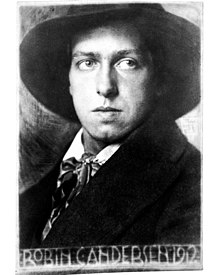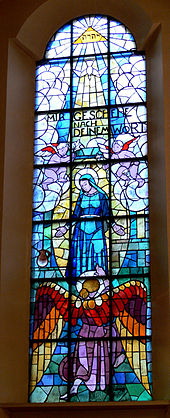Robin Christian Andersen

Robin Christian Andersen (born July 17, 1890 in Vienna , Austria-Hungary ; died January 23, 1969 in Vienna, Austria) was an Austrian painter .
Life
Robin Christian Andersen was the son of Christian Georgius Andersen from Denmark. He grew up in Moerkehus / Mammen in Jutland , Denmark and probably moved to Vienna around 1880, where he ran a decorative painting workshop. Mother Ida Franziska Camilla de Couvin came from Ödenburg / Sopron . Siblings were Ida Wilhelmine, Christine and Josefine. Ida Wilhelmine (1886–1919) married the painter Anton Faistauer in 1913 . The Andersen family stayed regularly in Mönichkirchen in Lower Austria and Styria exchange , where the family owned a summer house. Father Christian Georgius and his children retained Danish citizenship throughout their lives. 1905–1907 Andersen attended the Robert Scheffer painting school in Vienna. Artist colleagues were among others Anton Faistauer, Gustav Schütt, Anton Peschka and John Quincy Adams . In 1907 Andersen took the entrance exam at the Academy of Fine Arts Vienna , but he failed the exam. The competitor who also failed the entrance exam to the academy on the same date was Adolf Hitler . 1907–1908 Andersen attended Gustav Bauer (formerly Heinrich Strehblow) painting school in Vienna. In 1909 and 1910 Andersen went on study trips to Monte Verità near Ascona and to Italy with his former classmate and later brother-in-law Anton Faistauer and the painter Gustav Schütt . In 1911 Andersen took part in the Neukunstgruppe's “Special Exhibition Painting and Sculpture” on the premises of the artist group Hagenbund , from then on he was one of the members of the Neukunstgruppe in Vienna, which included Egon Schiele (1890-1918), Albert Paris Gütersloh , Anton Kolig and Anton Faistauer belonged. At the beginning of 1913, most of the members of the Neukunstgruppe joined the Association of Austrian Artists - Kunstschau. In 1914 Andersen married Johanna Bruha, known as Jenny, and the couple had a son who, however, presumably died in 1917 when he was still a child. Probably because of his Danish citizenship, Andersen was not called up for military service. In March 1918 Andersen took part in the legendary 49th Secession Exhibition organized by Egon Schiele. Also in the spring of 1918, Andersen became a member of the New Secession Vienna, initiated by Egon Schiele, which dissolved after just a few months. In September 1918 Andersen was a co-founder of the Sonderbund of Austrian Artists Vienna initiated by Egon Schiele, from 1919-21 he held the function of secretary and manager in the Sonderbund. In 1919 and 1920 Andersen took part in the exhibitions of the Salzburg artists' association Der Wassermann . In 1920 he became a member of the Vienna Hagenbund, from which he resigned in 1923 at the latest. In 1920 Andersen organized an exhibition of the Sonderbund of Austrian Artists in the Kunstverein Winterthur , which was then shown in Geneva and Bern . From 1922, Andersen designed a number of tapestries for the tapestry manufactory in Vienna, which was founded in 1921. From 1931–1933 Andersen was a member of the commission for art purchases of the municipality of Vienna as well as the jury of the Federal Ministry of Education for the award of state honorary prizes to visual artists. After the self-dissolution of the Association of Austrian Artists - Kunstschau in 1932, Andersen and numerous other former members of the Association of Austrian Artists became members of the Vienna Secession . In 1938 or 1939 Andersen was awarded the title of professor. In the summer of 1945 Andersen was appointed to the Academy of Fine Arts Vienna and entrusted with the management of a master school for painting, which he held until his retirement in 1965. From 1946–1948 he was the rector of the academy. In 1967 the Vienna Secession organized an extensive retrospective by Andersen; it was the first and only solo exhibition during the artist's lifetime.
student
From 1919 to 1945 Andersen ran a private painting school in his studio in Vienna 4th, Margaretengürtel 96. Private students included Franz Elsner and Lisl Engels . Engels entered his studio at the age of 14 as the youngest student and took her first steps in still life and life drawing. At his master school for painting at the Academy of Fine Arts in Vienna, Andersen gave lessons strictly based on dogmatic teaching methods. However, many students found such classes no longer up-to-date and too restrictive. For example, the later main exponents of the Vienna School of Fantastic Realism , Arik Brauer , Ernst Fuchs , Wolfgang Hutter , Anton Lehmden , initially entered Andersen's master school in 1945/46, only to leave it after a few months and join Albert's class Paris Gütersloh to switch. Also Friedensreich Hundertwasser was in 1949 only a few months in Andersen's class to rely on the academy altogether. Andersen's students who later became known include Kurt Absolon , Eduard Angeli , Joannis Avramidis , Liselott Beschorner, Johann Fruhmann , Leopold Ganzer , Franz Grabmayr , Giselbert Hoke and Alfred Kornberger .
Works (selection)
Robin Christian Andersen is one of the representatives of a figurative mode of representation that strives for a synthesis of formal rigor and impulsive painting gesture. Andersen's early works, created around and before the First World War, show an intensive examination of the art of Paul Cézanne , which was to result in the artist's lifelong love of still lifes and landscapes. A stylistic similarity to the work of his brother-in-law Anton Faistauer can also be seen in many of the pictures . In the 1920s there was an approach to the New Objectivity style , which in the 1930s resulted in a visual language that can be described as a synthesis of painterly expressive and neo-objective stylistic elements. In the works of the 1940s and 1950s, heightened geometrical rigor and, in some cases, an approach to gestural abstraction is noticeable. The largest number of paintings by Andersen in institutional hands is now owned by the Leopold Museum , Vienna, followed by the Austrian Gallery Belvedere , Vienna. Larger groups of works on paper can be found in the Albertina , Vienna, and in the Kupferstichkabinett of the Academy of Fine Arts Vienna . The majority of the artist's painterly oeuvre, however, is still scattered privately today.
Paintings (selection)
- “Mädchen beim Ankleiden”, 1913, oil on canvas, 120 × 81.5 cm, private collection
- “Still life, bowl and clay jugs” 1913, oil on canvas, 49 × 69 cm, private property, Salzburg
- Still life with fruit on white cloth, 1913, oil on canvas, 60 × 80.5 cm, Stark Collection, Vienna
- “Portrait of a girl in a blue dress”, 1913/14, oil on canvas, 70 × 56 cm, Leopold Museum, Vienna, inv. 33
- Flowers in a white vase, 1917, oil on canvas, 50 × 40 cm, Austrian Gallery Belvedere, inv.-no. 5169
- Wehr in Aspang, 1921, oil on canvas, 70 × 96 cm, Landesmuseum Niederösterreich, inv. A 776/99
- “Landscape from Aspang”, 1924, oil on canvas, 63 × 88 cm, Austrian Gallery Belvedere, inv. 2500
- Young woman with bare back - “Female nude from the back”, around 1925, oil on canvas, auctioned by the Kinsky auction house, Vienna 2014
- "Female Nude (Eva with the Apple)", 1928/29, oil on canvas, 160.5 × 53.5 cm, Courtesy Giese & Schweiger, Vienna
- “Flower Landscape”, 1928, oil on canvas, 87.5 × 115 cm, Austrian Gallery Belvedere, inv. 2836
- “Family portrait Rodulfo Oyarzún Philippi”, 1929, oil on canvas, Victor Oyarzun Körner, Los Andes, Chile
- Still life with grapes, lemons and tomatoes, 1929, oil on canvas, 60.5 × 92 cm, Österreichische Galerie Belvedere, inv. 3230
- Still life with fruit, fruit bowls and pumpkin on a table, around 1929, oil on canvas, 72.5 × 100.1 cm, Leopold Museum, Vienna, inv. 365
- Still life with two fruit plates on and under a stool, around 1930, oil on canvas, 68.2 × 55.4 cm, Leopold Museum, Vienna, inv. 422
- Still life with begonias and tomatoes, around 1935, oil on canvas, 87 × 115 cm, Museum der Moderne Salzburg, Inv. BU 3728
- “Landscape from Pitten”, 1935, oil on canvas, 75 × 99.8 cm, Austrian Gallery Belvedere, inv. 3316
- “Still life with corn on the cob”, around 1936, oil on hardboard or canvas, 82 × 111 cm, Courtesy Kunsthandel Wienerroither & Kohlbacher, Vienna
- “Self-portrait”, around 1940, oil on canvas, 100 × 71.5 cm, Austrian Gallery Belvedere, inv. 3791
- "Playing boys (movement study)". Painted variant of the tile mural “Life on the Water” in Vienna 16., around 1952, oil on hardboard, 64 × 84 cm, private property, Vienna
- “Danube between Leopoldsberg and Klosterneuburg”, around 1952, oil on canvas, 82 × 107 cm, Wien Museum, inv. 105.118
- Landscape with a lake, around 1952, oil on canvas, 50.7 × 60.2 cm, Leopold Museum, Vienna, inv. 566
- Still life with a fruit bowl, pumpkin plate and cups, around 1954, oil on canvas, 59 × 65.5 cm, Courtesy Giese & Schweiger, Vienna
- “Roofs of Mönichkirchen with Wild Goose House I”, around 1957, oil on canvas, 83 × 107.5 cm, Leopold Museum, Vienna, inv. 446
- Die Klavierträger, around 1959, oil on canvas, 100 × 119 cm, private property California, Courtesy Kunsthandlung Zöchling, Vienna
Designs for tapestries
- “Verdure with monkeys and birds”, executed by the tapestry manufactory in Vienna, 1922, 190 × 250 cm, Austrian Museum of Applied Arts, Vienna
- "Heron on the water", executed by the tapestry manufactory in Vienna, 1923, 176 × 207 cm, Belvedere, Vienna, inv. 2834, on permanent loan to the Austrian Museum of Applied Arts, Vienna
- "Pulling Herons in the Reeds", executed by the Viennese Gobelin Manufactory, 1924, approx. 300 × 400 cm, Oesterreichische Nationalbank Wien, burned in 1979
- “Swastika on a flower ground”, executed by the tapestry manufactory in Vienna, 1938, 210 × 280 cm, Austrian Museum of Applied Arts, Vienna
Other work
- Five so-called painted tapestries for the festival hall, Großes Festspielhaus , Salzburg, 1926, each 215 × 175 cm
- Four glass windows for the parish church of Bregenz-Mariahilf in Bregenz-Vorloster, 1931, each 685 × 200 cm, drafts based on sketches by Anton Faistauer, executed by the Innsbruck glass painting company
- Wall frieze "Jesus blesses the children and the sick" for the entrance hall of the children's hospital of the C. M. Frank Foundation in Lilienfeld, 1935, 200 × 1000 cm, the wall frieze was later painted over
- Draft for glass windows in the stairwell of the tobacco factory Linz , 1935, 218 × 391 cm, executed by Josef Raukamp , Linz
- Mural “Life on the water” for the residential complex in Vienna 16., Wernhardtstrasse 12–16, painted tiles, 700 × 350 cm. The preparatory work began in 1952, the official commission from the City of Vienna took place in 1954, and the work was carried out in 1957 with the support of the ceramic artist Herta Bucher
Awards
- 1925: Gold Medal of Honor from the Vienna Künstlerhaus
- 1933: Award of the Julius Reich Artist Foundation Prize of Honor
- 1953: Prize of the City of Vienna for Fine Arts
literature
- General artist lexicon Internationale Künstlerdatenbank Online, De Gruyter Saur, article written by Kristian Sotriffer, 1992, p. 386
- Franz Smola, the painter Robin Christian Andersen (1890-1969). Life and work. With a catalog raisonné of all artistic works. Vienna, dissertation, University of Vienna 2017, 2 volumes
Web links
- Belvedere Online: Robin Christian Andersen
- Albertina Online: Robin Christian Andersen
- Robin Christian Andersen on artnet
- Robin Christian Andersen (German / English)
| personal data | |
|---|---|
| SURNAME | Andersen, Robin Christian |
| BRIEF DESCRIPTION | Austrian painter |
| DATE OF BIRTH | July 17, 1890 |
| PLACE OF BIRTH | Vienna |
| DATE OF DEATH | 23rd January 1969 |
| Place of death | Vienna |
